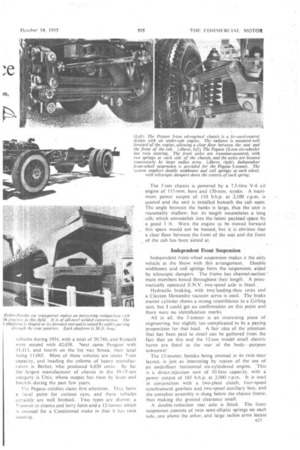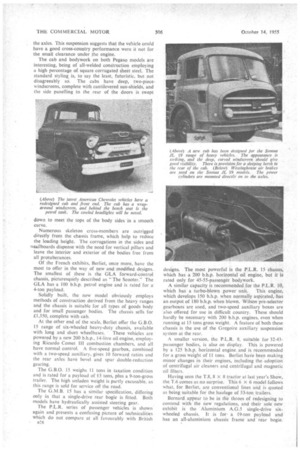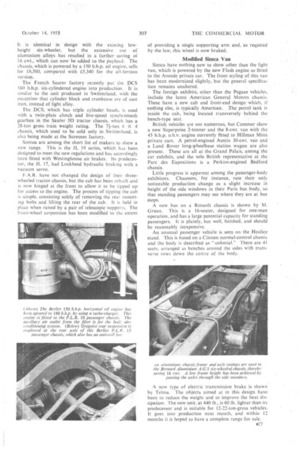The Law Slows Progress in F
Page 58

Page 59

Page 60

Page 61

If you've noticed an error in this article please click here to report it so we can fix it.
THE time difficulties associated with the design and construction of commercial vehicles are brought forcibly to mind at the 42nd Paris Salon, which opened on October 6 and closes on Sunday. The new regulations affecting the construction of French vehicles were introduced shortly before last year's Show, but manufacturers have not had sufficient time to offer completely new ranges. For this reason, the Show is devoid of novelties from the home country.
TQ British eyes, the most interesting stand this year is that occupied by the Ypanish Pegaso exhibits, which have not been shown at any of the previous Con
tinental motor exhibitions. Other new vehicles are to be seen on the Berliet, Bernard, Saurer and Sornua stands, and most exhibitors are able to claim slight modifications.
Despite this temporary stagnation, the French vehicle industry as a whole seems fairly healthy and production is still rising steadily. During 1954, 152,613 goods and 3,185 passenger vehicles were produced, representing increases of 28,587 and 1,031 units respectively over
the previous year's figures. A total of 30,587 goods and passenger vehicles was exported last year—approxi mately 33 per cent, more than in 1953.
Citroen produced the greatest number of commercial B24
vehicles during 1954, with a total of 50,740, and Renault were second with 42,658. Next carne Peugeot with 31,41.3, and fourth on the list was Simca, their total being 11,065. Most of these vehicles are under 7-ton capacity, and heading the column of heavy manufacturers is Berliet, who produced 6,620 units. By far the largest manufacturer of chassis in the 10-15-ton category is Unic, Whose output has risen by leaps and bounds during the past few years.
The Pegaso exhibits claim first attention. They form a focal point for curious eyes, and these vehicles certainly are well. finished. Two types arc shown: a 5-tonner in chassis and lorry form and a 12-tonner which is unusual for a Continentalmake in that it has twin steering. The 5-ton chassis is powered by a 7.5-litre V-6 eil engine of 115-mm. bore and 120-mm. stroke. A maximum power output of 110 b.h.p. at 2,100 r.p.m. is quoted and the unit is installed beneath the cab seats. The angle between the banks is large, thus the unit is reasonably shallow, but its length necessitates a long cab, which .encraache-s into thellatent paylOad,spacel bya good 3 ft. Were the engine to be moved forward this SPace would not be wasted, but it i.s obvious that a clear floor between the front of the seat and the frofit of the cab has been aimed at.
Independent Front Suspension Independent front-wheel suspension makes it the only vehicle at the Show with this arrangement. Double wishbones and coil springs form the suspension, aided by telescopic dampers. The frame has channel-section.' main members boxed throughout their length. A pneumatically operated E.N.V. two-speed axle is fitted:, •
Hydraulic braking, with two-leading-shoe units and a Clayton Dewandre vacuum servo is uSed., The brake master cylinder shows a strong resemblance to a unit, but I could get no confirmation on this point and there were no identification marks.
All in all, the 5-tonner is an interesting piece of engineering, hut slightly too complicated to be a paying proposition for that load. A fair idea of the attention that has been paid to detail can be gathered from the fact that on this and the 12-ton model small electric horns are fitted to the rear of the body—purpose unknown!
The 12-tonner, besides being unusual in its twin-steer layout, is just as interesting by reason of the use of an underfloor horizontal six-cylindeted engine. This is a direct-injection unit of 10-litre capacity, with a power output of 165 b.h.p. at 2,000 r.p.m. It is used in conjunction with a two-plate clutch, four-speed synchromesh gearbox and two-speed auxiliary box, and the complete assembly is slung below the chassis frame, thus making the ground clearance small.
A double-reduction rear axle is fitted. The front suspension consists of twin semi-elliptic springs on each side, one above the other, and large radius arms locate ril/5
the axles. This suspension suggests that the vehicle could have a good cross-country performance were it not for the small clearance under the engine.
The cab and bodywork on both Pegaso models are interesting, being of all-welded construction employing a high percentage of square corrugated sheet steel. The standard styling is, to say the least, futuristic, but not disagreeably so. The cabs have deep, two-piecewindscreens, complete with cantilevered sun-shields, and the side panelling to the rear of the doors is swept
down to meet the tops of the body sides in a smooth curve.
Numerous skeleton cross-members are outrigged directly from the chassis frame, which help to reduce the loading height. The corrugations in the sides and utailboards dispense with the need for vertical pillars and leave the interior and exterior of the bodies free from all protuberances.
Of the French exhibits, Berliet, once more, have the most to offer in the way of new and modified designs.
The smallest of ,these is the GLA forward-control chassis, picturesquely described as The Scooter." The
GLA has a 100 b.h.p. petrol engine and is rated for a 4-ton payload.
Solidly built, the new model obviously employs methods of construction derived from the heavy ranges and the chassis is suitable for all types of goods body and for small passenger bodies. The chassis sells for £1,350, complete with cab.
At the other end of the scale, Berliet offer the G.B.O. 15 range of six-wheeled heavy-duty chassis, available with long and short wheelbases. • These vehicles are powered by a new 200 b.h.p., 14-litre oil engine, employ ing Ricardo Comet Ill combustion chambers, and all have normal control. A five-speed gearbox, combined with a two-speed auxiliary. gives 10 forward ratios and the rear axles have bevel and spur double-reduction gearing.
The G.B.O. 15 weighs 11 tons in taxation condition and is rated for a payload of -15 tons, plus a 9-ton-gross
trailer. The high unladen weight is partly excusable, as this range is sold for service off the road.
The G.M.B. 15 has a similar specification, differing only in that a single-drive rear bogie is fitted. Both models have hydraulically assisted steering gear.
The P.L.R. series of passenger vehicles is shown again and presents a confusing picture of technicalities which do not compare at all favourably with British R26 designs. The most powerful is the P.L.R. 15 chassis, which has a 200 b.h.p. horizontal oil engine, but it is rated only for 45-55-passenger bodywork.
A similar capacity is recommended for the P.L.R. 10, which has a turbo-blown power unit. This engine, which develops 150 b.h.p. when normally aspirated, has an output of 180 b.h.p. when blown. Wilson 'pre-selector gearboxes are used, and two-speed auxiliary boxes are also offered for use in difficult country. These should hardly be necessary with 200 b.h.p, engines, even when running at 15 tons gross weight. A feature of both these chassis is the use of the Gregoire auxiliary suspension system at the rear.
A smaller version, the P.L.R. 8, suitable for 32-43passenger bodies, is also on display. This is powered by a 125 b.h.p. horizontal engine, and is recommended for a gross weight of 11 tons. Berliet have been making minor changes in their engines, including the.adoption of centrifugal air cleaners and centrifugal and magnetic oil filters.
Having seen the T.8, 8 x 8 tractor at last year's Show, the T.6 comes as no surprise. This 6 x 6 model follows what, for Berliet, are conventional lines and is quoted as being suitable for the haulage of 53-ton trailers.
Bernard appear to be in the throes of redesigning to contend with the new regulations, and their sole new exhibit is the Aluminium A.G.5 single-drive sixwheeled chassis. It is for a I9-ton payload and has an all-aluminium chassis frame and rear bogie.
It is identical in-design with the existing lowheight six-Wheeler, but the extensive use of aluminium alloys has resulted in a:. further saving of 16 owt.,-wbich can now be added to the payload. The chassis, which is powered by a 150 b.h.p. oil engine, sells for i6,500, compared with :0,346 for the all-ferrous version., The French Saurer factory recently put the DCS 160 b.lf.p::Sik-cylindered engine into production. It is sintilar to the unit produced in Switzerland, with the exception'that cylinder block and crankcase are of cast iron, instead of light alloy. The .pcs, which has triple cylinder heads, is used with a twin-plate clinch and five-speed synchromesh gearbox in. the Sauer ..5D tractor chassis, which has a 28-ton gross train Weight rating. The 7*-ton 4 > 4 chassis, Which used to be sold orily• in Switzerland, is also being made at the Suresnes factory.
Sornua are among the short list of makers to show a new range. This is the IL 19 series, which has been designed to meet the new regulations and has accordingly been fitted with Westinghouse air brakes. Its predecessor, the IL 17, had Lockheed hydraulic braking with a vacuum servo.
F.A.R. have not changed the design of their threewheeled tractor chassis, but the cab has been rebuilt and is now hinged at the front to allow it to be tipped up for access to the engine. The process of tipping the cab is simple, consisting solely of removing the rear mounting bolts and lifting the teat of the cab: It is held in place when raised:by a pair of telescopic supports. The front-wheel suspension has been modified to the extent
of providing. a single supporting arm and, as required by the law, this wheel is now braked.
Modified Simca Van
Simca have nothing new to show other than the light van, which is powered by the new Flash engine as fitted to the Aronde private car. The front styling of this van has been modernized slightly, but the general specification remains unaltered:
The foreign exhibits, other than the Pegaso vehicles, include the latest American General Motors chassis. These have a new cab and frorit-end•design. which, if nothing else, is typically American. The petrol tank is inside the cab, being located transversely behind the bench-type seat.
British vehicles are not numerous, but Commet show a new Superpoise .-tonner and the 8-cwt. van with the 43 b.h.p. o.h.v. engine currently fitted to Hillman -Minx private cars, A petrol-engined Austin 30-cwt. van and a Land Rover long-Theelbase station wagon are also present. These are all at the Grand .Palais; ambng the car exhibits, and the sole British representative at the Parc des Expositions is a Perkins-engined Bedford chassis.
Little progress is apparent among the passenger-body exhibitors. Chausson, for instance, rate their only noticeable production change as a slight increase in height of the side windows in their Paris bus body, -so that standing passengers may see where they are at bus stops.
A new bus on a Renault chassis is shown by M. Gruau. This is a 16-seater, designed for one-man operation, and has a large potential capacity for standing passengers. It is plainly, but well, finished, and should be reasonably inexpensive.
An unusual passenger vehicle is seen on the Heuliez stand. This is based on a Citroen normal-control chassis and the body is described as colonial." There are 41 seats, arranged as benches around the sides with transverse rows down the centre of the body.
A new type of electric transmission brake is shown by Telma. The objects aimed at in this design have been to reduce the weight and to improve the heat dissipation. The new unit, at 440 lb., is 60 lb. lighter than its predecessor and is suitable for 12-22-ton-gross vehicles. It goes into production next month. and within 12 months it is hoped to have a complete range for sale.




















































































































